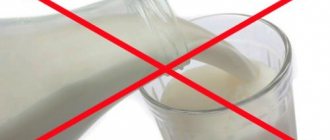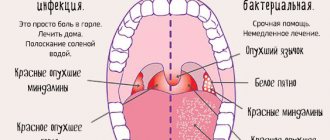A hoarse throat with or without fever is not as simple a symptom as it might seem at first glance. It can be a consequence of a common cold, or it can signal dangerous diseases. Therefore, when hoarseness appears, the first thing to do is to show the child to an ENT doctor.
Hoarse throat: diagnosis and how to treat?
In order to correctly diagnose and determine the cause of hoarseness, the ENT doctor conducts a thorough diagnosis of the little patient. First, the doctor interviews parents about complaints and symptoms. Then he examines the nasopharynx using endoscopy, palpates the lymph nodes, and, if necessary, performs laryngoscopy (examination of the larynx). If the problem does not lie in the ENT organs, you will need to consult doctors of related specialties: an allergist, oncologist, etc. If the cause of hoarseness is infectious, you will need to undergo a series of laboratory tests.
Friends! Timely and correct treatment will ensure you a speedy recovery!
How to treat hoarseness? Depending on the reason that caused it. Therapy may include:
- antibacterial or antiviral drugs (depending on the causative agent of inflammation);
- antipyretics for fever;
- antiseptic sprays;
- lozenges;
- rinsing solutions;
- cough suppressants;
- physiotherapeutic procedures.
antihistamines that relieve swelling;
If hoarseness is caused by overstrain of the ligaments, vocal rest, plenty of warm drinks and maintaining the proper level of humidity in the apartment are necessary.
Prevention.
To avoid dangerous consequences for children's health, do not forget to vaccinate your baby according to the vaccination calendar, in particular, vaccinate against diphtheria.
Treat respiratory diseases promptly. Contact your doctor at an early stage, when the disease can be treated quickly and without complications.
Temper your child, including using local hardening of the throat: even ice cream eaten in small portions will benefit local immunity. Walk in the fresh air more often, teach your baby to sports and physical activity.
Maintain optimal levels of humidity and temperature in the room.
Avoid crowded places during epidemics. If this cannot be avoided, thoroughly wash your baby’s hands and rinse his nasal passages with saline solutions.
It seems like simple rules, but if you follow them, you won’t have to treat serious illnesses.
If you or your family members do get sick, do not self-medicate, but rather come to our ENT clinic. We treat adults and small patients from three years of age.
To make an appointment, please call: +7 (495) 642-45-25;.
Causes of hoarseness
The main causes of a hoarse voice include:
- Allergic reactions - if a child is allergic to some product or chemical, then when the allergen enters the oral cavity, swelling of the larynx occurs (this happens in a matter of minutes). At the same time, it becomes not only difficult for the patient to speak, but also to breathe. In this case, urgent medical attention is needed, otherwise the consequences can be disastrous.
- Overstrain of the vocal cords - this often occurs after prolonged crying, singing or screaming, resulting in hoarseness or temporary loss of voice.
- Infectious diseases (including acute respiratory viral infections and influenza) - develop as an independent pathology or as a result of untreated colds, as a complication, for example, laryngitis, tracheitis, etc. Under the influence of pathogenic bacteria, the vocal cords become inflamed and swelling of the larynx occurs.
- Injuries to the larynx - occur as a result of mechanical damage (for example, after a blow to the neck, when participating in sports events, etc.).
- Getting a foreign object into the throat - both food particles (for example, bones from fish, fruits and berries) and household foreign bodies (nails, buttons, coins, small toys, etc.) can get into the child’s larynx. As a result, not only the voice disappears, but the airways are blocked (including a strong cough or even a short-term loss of consciousness). Therefore, the situation requires urgent medical attention.
- Severe fear and nervous stress - in such cases, the voice usually recovers on its own (after some time). But you may need the help of a psychologist.
Only an otorhinolaryngologist (ENT) can determine the exact cause of hoarseness after an appropriate examination.
Features of therapy
Hoarseness in a child often occurs within an hour and takes parents by surprise. As a rule, this symptom precedes the further spread of infectious pathogens through the respiratory tract. To prevent the development of events in such a negative scenario, some mothers and fathers begin to give the baby antiviral pills or urgently put on mustard plasters.
The doctor should examine the child's larynx, since it is possible that a foreign object is present in the respiratory tract. The child could receive an injury while playing with peers, which is not noticeable externally, but provokes:
- swelling of the mucous membranes of the respiratory tract;
- inflammatory process in the tissues of the throat.
The development of allergic reactions cannot be ruled out, even if the child has not previously experienced them. In this case, there is no need to take expectorants - improvement will occur only after taking antihistamines (Zodak, Erius, Suprastin).
Young children are curious and are attracted to bottles containing household chemicals with bright stickers. Often the liquids they contain have a pleasant citrus or vanilla smell. After tasting this product, a child may get a chemical burn, which manifests itself in hoarseness and coughing.
It is necessary to treat a hoarse voice in a small child in a comprehensive manner, using medications and health-improving procedures recommended by the doctor. If the cause of dysphonia is a cold, then a correctly drawn up therapeutic regimen consists of the following measures:
- destruction of pathogenic viruses and bacteria;
- converting a dry cough into a productive wet form;
- use of expectorants to thin and remove mucus;
- the use of antihistamines to relieve swelling;
- increasing immunity.
From the very beginning of treatment, pediatricians recommend giving children vitamin complexes with microelements. Manufacturers produce drugs for children in chewable form in the form of bears, fish or fruits. These vitamins include Vitrum, Jungle Kids, Supradin for children.
Treatment of hoarseness in a child should begin with taking vitamins
Symptoms of pathology
Along with hoarseness, symptoms such as:
- Hoarseness in the voice.
- Prolonged dry cough.
- Difficulty breathing (sometimes whistling) and swallowing.
- Rough voice.
- Increased body temperature (especially with viral infections).
- Increased salivation.
- A sore throat.
- Fatigue and decreased physical activity.
Note! A hoarse voice and cough are the first “alarm bells” for parents to take appropriate measures.
Drug treatment
After a preliminary examination, children with a hoarse voice are usually prescribed the following medications:
- Inhalipt is an antimicrobial and anti-inflammatory agent for the treatment of diseases of the larynx, produced in the form of an aerosol and spray. Active ingredients: mint and eucalyptus oils. The drug is recommended for inhalation (spray into the oral cavity for 1-2 seconds, towards the larynx). Irrigate 3-4 times a day. Before the procedure, it is advisable to rinse your mouth with boiled water.
- Lizobakt is an antiseptic and antiviral agent that relieves inflammation and swelling, thereby restoring the voice. The drug is available in the form of lozenges. The active ingredients are lysozyme hydrochloride and pyridoxine hydrochloride. Children aged 3-12 years are recommended to take 1 tablet. Children over 12 years of age can take 2 tablets. Frequency of use: 3-4 times a day. On average, the course of treatment is one week (but if there are no results, it can be extended).
- Miramistin is an antimicrobial and antifungal agent that is used for topical use. Available in the form of a solution. The main active ingredient is benzyldimethyl. The drug should be used to irrigate the oral cavity 2-3 times a day. The course of treatment is 3-5 days. Effective in complex therapy.
- Zodak is an antihistamine and antiallergic drug, which is produced in the form of drops (for oral administration) and in the form of syrup. The active ingredient is cetirizine. Approximate dosage: children aged 1-2 years, give 5 drops 2 times a day, 2-6 years - 10 drops or 1 tsp. syrup 2 times a day, 6-12 years and older - 20 drops or 2 tsp. syrup 2 times a day. Before use, the drops must be dissolved in a small amount of water. Therapy lasts until the allergy that caused hoarseness is eliminated.
Before using this or that drug, preliminary consultation with a specialist is required.
Treatment with pharmacological drugs
For hoarseness or hoarseness of voice, doctors prescribe various lollipops, tablets and syrups for children. Daily and daily dosages, as well as the duration of the course of treatment, depend on the cause of the negative symptom, the age of the young patient, and the presence of pathologies in the anamnesis. Each disease requires the use of certain drugs in various combinations.
When recommending antibiotics or antivirals, the pediatrician relies on the results of laboratory tests of biological samples. If hoarseness is not accompanied by hyperthermia, and laboratory test samples do not reveal pathogenic pathogens, then pediatricians do not prescribe antibacterial or antimicrobial agents.
If the cause of your baby’s hoarse voice is a dry cough, then it should be converted into a wet, productive form. The pathology occurs against the background of severe swelling, which provokes a narrowing of the airways. The child suffers from bouts of painful coughing, which increase the load on the vocal cords.
You can eliminate a negative symptom with the help of tablets and syrups, the ingredients of which act directly on the cough center. These include:
- Codelac Neo,
- Omnitus,
- Libexin.
Medicines with beta blockers reduce the frequency of attacks and at the same time prevent the spread of the inflammatory process to the lower respiratory tract. Most often, pediatricians recommend the following drops and syrups for children:
- Sinekod,
- Flavamed,
- Stoptussin.
These drugs are not intended for simultaneous use with sputum thinners, since their pharmacological actions are completely opposite. This combination will not only slow down recovery, but can also cause unwanted complications, including bronchial asthma and pneumonia.
When a child has a very hoarse voice against the background of a wet cough, it is necessary to take medications to reduce the viscosity of sputum and remove it from the respiratory tract. To do this, you can use mucolytics with the active ingredient acetylcysteine. Typically, pediatricians recommend ACC at a dosage of 100 mg for young children, and 200 mg for older children.
After using mucolytics, sputum is no longer so strongly attached to the walls of the larynx, so it needs to be removed from the respiratory tract. Mucokinetics and expectorants accelerate the evacuation of mucus during coughing:
- marshmallow and licorice syrups,
- Pertussin,
- Bromhexine,
- Ambroxol and its analogues: Ambrobene, Lazolvan, Bronchorus.
Medicines restore the functional activity of epithelial cilia, which clean the surface of the mucous membranes from sputum and pathogens of infectious pathologies. After eliminating the wet cough, the condition of the ligaments is normalized, and the voice acquires its previous timbre.
The time-tested remedy Pertussin helps children treat hoarse voices
Kids love not only medicinal syrups with strawberry or orange additives, but also lollipops that resemble delicious candies.
They relieve pain, soften ligaments and a sore throat, and eliminate coughing attacks that occur due to irritation of receptors on the mucous membrane of the larynx. Pediatricians recommend tablets, lozenges, dragees, and lozenges with chamomile, licorice, ginger, and sage for children.
These ingredients have a pronounced anti-inflammatory and antiseptic effect. The following medications will help restore a child’s shrunken voice:
- Strepsils,
- Falimint,
- Faringosept,
- Septolete,
- Antiangin.
Throat sprays
When children lose their voice, doctors recommend using medications in the form of aerosols. The active ingredients of such drugs have antimicrobial, emollient, and anti-inflammatory properties. If the baby’s hoarse voice is not accompanied by other negative symptoms of a cold, then sprays will do an excellent job of coping with the problem. Most often, pediatricians prescribe the following medications:
- Theraflu Lar,
- Miramistin or Chlorhexidine,
- Hexoral,
- Lugol,
- Inhalipt.
Experienced doctors do not recommend using sprays in the treatment of children under 3 years of age. Babies have many blood vessels in the mucous membranes of the respiratory tract. If they are exposed to a powerful aerosol jet, a dangerous laryngospasm or allergic reaction may develop.
A child's hoarse voice indicates severe swelling of the upper respiratory tract, caused by an inflammatory process. In this case, pediatricians always prescribe the latest generation antiallergic drugs that do not cause drowsiness:
- Loratadine,
- Cetirizine,
- Claritin.
In addition to reducing the severity of edema, these medications help avoid the development of an allergic reaction as a result of taking a significant amount of pharmacological drugs.
Traditional methods of treatment
A hoarse voice is successfully treated with traditional medicine. Here are some recipes:
- Rinse with herbal decoction - 1 tsp. dry chamomile and 1 tsp. Pour a glass of boiling water over the eucalyptus herbs and cool until warm. Gargle with the broth 3-4 times a day (until hoarseness disappears).
- Carrots with honey - mix honey and freshly squeezed carrot juice in equal proportions. Take the product 1 tsp. up to 5 times a day (until complete recovery).
- Raspberry leaf decoction - finely chop dried raspberry leaves and pour 100 g of dry herb into 1 liter of boiling water, let it brew for 1.5 hours. Take half a glass three times a day (until your voice is restored).
A child's hoarse voice may be a sign of a serious pathology that requires immediate treatment. But it is often the result of mechanical damage, ligament strain or fright. To find out the true cause, you need to consult a doctor. Otherwise, the situation may worsen (up to complete loss of voice, requiring long-term therapy).
Treatment must be comprehensive (including traditional methods) and under the supervision of a specialist. If the cords are given the necessary rest and the doctor’s recommendations are followed, then the child has every chance of restoring his voice in the near future.
Traditional medicine recipes for hoarseness
Traditional methods of treating hoarseness are very popular, let's find out what herbalists and healers offer us.
For many years, knowledge has been passed on from mouth to mouth, making it possible to treat various ailments with simple and accessible methods, which is very relevant today. Hoarseness in children and adults is quite common, so folk medicine already has means to improve this condition.
Inhalations with essential oils
Add 5 drops of mint, eucalyptus or sage oil to a liter saucepan of water (temperature approximately 45 degrees). Mix the mixture well. We cover the child with a towel and ask him to inhale the vapor. Inhalation is performed for about 5 minutes. The number of procedures depends on the general symptoms, as well as hoarseness.
Potato inhalations
Potatoes are boiled in their skins, and then cut into four quarters, without removing the skin. The child is seated on a high chair and asked to breathe deeply in pairs. The potatoes should cool slightly so that the hot steam does not burn the mucous membrane of the nasopharynx. Usually a three-day course is enough to restore your voice.
Chamomile-lavender inhalations
The duo of these herbs has a powerful anti-inflammatory effect. Inhalations eliminate swelling, hyperemia, and pain. After the inflammatory process subsides, the vocal cords immediately return to normal.
The composition for inhalation is prepared as follows: chamomile and lavender are mixed in a 2:1 ratio, poured with boiling water, and left in a water bath for 5 minutes. For 15 grams of mixture you need 500 ml of boiling water. Cool to 45 degrees. Inhalations are performed over a saucepan for 5 minutes, no longer necessary.
Foot baths with mustard powder
Baths with mustard give good results for swelling and hoarseness. Place a generous pinch of powder into a medium-sized bowl of warm water and shake thoroughly. The solution should be warm enough (tolerable), but not hot. Higher concentrations of mustard powder are also not needed, because they can cause allergies and irritation to the delicate skin of children.
You need to steam your feet before going to bed, then put on warm socks and go to bed. After mustard baths, you can give your child an infusion of raspberries, linden blossom, or regular milk with honey. This method is suitable in case of colds, hypothermia, when body temperature does not exceed 37.3 degrees.
Beetroot juice – gargling
The juice is diluted half and half with water, but this is not necessary. If well tolerated, whole juice can also be used. Rinses are performed in the morning and evening. The results of rinsing will please many parents, because... Beet juice perfectly helps not only against hoarseness, but is also an effective remedy in the fight against tonsillitis, sore throat, purulent plugs, and pharyngitis.
To boost immunity, it is recommended to give children the following drink: take beet and carrot juice in equal parts. Then add boiled water. The juice mixture is diluted 1:1 with water. The drink is taken as a course for 10 days, then a break of 14 days, and therapy is resumed again.
Butter with honey
This remedy perfectly treats all diseases of the respiratory system, ranging from common colds to pulmonary tuberculosis. You don't have to adhere to exact proportions. The main thing in this recipe is to melt the honey and butter in a water bath and mix this mixture thoroughly. Generally, it is recommended to use 2 parts oil and 1 part honey. Take a dessert spoon 2-3 times a day.
Honey oil perfectly coats the throat and relieves inflammation. Many children know the fairy tale about a cockerel whose neck was oiled and he recovered. Therefore, when a child grimaces and refuses such treatment, savvy parents will definitely tell a good story, chat the baby up, and force him to take the buttery sweetness.
Aloe with honey
Aloe juice and honey mixed in a 1:1 ratio will help cure your throat. The mixture is taken three times a day until all symptoms of the disease disappear. Aloe relieves inflammation, eliminates bacteria, improves local and general immunity. Hoarseness goes away after 2–3 days.
Baked apples
Apples contain a large amount of pectin, and when baked they acquire a soft, mushy structure that has an anti-inflammatory and softening effect. There is nothing tricky about this recipe. Just give your child a medium baked apple three times a day. If your baby is allergic, take only greener fruits.
Sage milk
Add 10 ml of sage infusion to a glass of hot milk and drink immediately. This composition will help eliminate hoarseness and cough due to tracheitis, bronchitis, and throat diseases. It is better to drink milk at night to warm up well.
Milk + iodine + soda
A simple recipe will help quickly restore the vocal cords: add a pinch of soda and 2 drops of iodine to warm boiled milk (200 ml). Milk is given to the child before bedtime. The mixture will eliminate hoarseness and cough, enable the child to sleep peacefully and restore weakened breathing.
Rosehip with honey
Many people know this remedy as a storehouse of vitamins and microelements. Rosehip is always prescribed to weakened patients, when the immune system is practically exhausted. For hoarseness, it is recommended to drink rosehip infusion: 100 grams of fruit per 1 liter of boiling water. It is better to steam rose hips in the evening using a thermos.
Drink the infusion three times a day, 100–200 ml. You can add honey to improve the taste.
Gogol-mogol
The method is more familiar to the older generation, and, probably, it is undeservedly forgotten, but in Soviet times, it was considered almost a panacea for hoarseness and problems with ligaments.
Prepare eggnog according to this recipe: fresh yolks are thoroughly ground with sugar (2 yolks + 5 grams of sugar). The mixture is supplemented with butter (5 grams). You should get a homogeneous mixture. Gogol-mogol is taken in between meals. Children are given 0.25–0.5 tsp. three times a day.
The main causes and methods of treating hoarseness in a child
Hoarseness in a child is dangerous because it can be caused by an inflammatory process in the larynx, which can cause difficulty in the respiratory process and disrupt normal ventilation of the lungs. An additional risk arises because children have narrower throats than adults, so even seemingly normal hoarseness and throat swelling can be more aggressive.
Hoarseness in children is not considered an independent disease, but is classified as a condition that is caused by certain factors. Some of them are harmless, but there are also causes that are dangerous to health and life.
Hoarseness in a child may occur in the following cases:
- 1. Overstrain of the vocal cords. The reason for this may be loud talking, crying, screaming, singing and other actions that lead to microtrauma of the sensitive mucous membrane of the larynx with rupture of small capillaries. Swelling is usually observed along with wheezing.
- 2. Flu and various colds that cause inflammation of the larynx (laryngitis), bacterial or viral. To a greater extent, a hoarse voice is accompanied by a runny nose, barking cough, pain in the throat and fever.
- 3. Damage to the larynx by foreign objects. This condition is life-threatening and requires immediate diagnosis and medical assistance for the patient, as there is a risk of a foreign body passing down the respiratory tract and blocking it. In this situation, the child will experience a paroxysmal cough that cannot be eliminated with medications, paleness of the skin of the face, difficulty breathing, and in rare cases, loss of consciousness.
- 4. Injuries to the larynx. Typically, a child wheezes due to damage to the mucous membrane of the larynx due to a blow to the front or side of the neck.
- 5. Allergic reaction. Some children may have increased sensitivity to certain foods, pollen, insect bites, etc. When the mucous membrane of the larynx is irritated, swelling is provoked, and hoarseness is the first sign of stenosis, which is life-threatening due to an acute lack of oxygen.
- 6. Change in voice during puberty. Often, due to hormonal changes in children, their voice may change. It usually becomes hoarse, but there is also the possibility of shrillness. This process is physiologically normal if the voice is restored within 6 months. In other cases, it is recommended to consult a doctor.
- 7. Severe emotional shock or excitement. Speech and voice may be impaired in unusual situations and should recover without assistance after the child has been calmed down.
The most dangerous and least likely cause of hoarseness in a child is diphtheria croup. Today, all children are vaccinated against diphtheria, which makes it possible to minimize the incidence of this disease. But you should not completely exclude the possibility of infection, since this can happen even in a vaccinated baby.
If severe hoarseness occurs, you should call an ambulance. Until medical personnel arrive, parents should ensure that the child drinks plenty of fluids and is completely at rest.
Why is my voice hoarse?
A hoarse voice in a baby can occur for the following reasons:
- The baby cries too long and often. If the ligaments are strained for a long time, the vessels supplying blood to the oropharynx can be damaged. As a result, swelling occurs, which makes the voice hoarse;
- a hoarse voice in a baby may occur due to the presence of any neoplasms in the pharynx, for example, papillomas;
- inflammatory diseases of the larynx. Parents may notice that the baby is hoarse if the child has contracted a bacterial or viral infection. At the same time, symptoms such as fever, cough, decreased appetite, anxiety and moodiness, and bowel dysfunction may be observed;
- injuries to the neck and throat area. In this case, a hoarse voice may be accompanied by a change in the position of the child’s head, bruises on the front or side of the neck.
Frequent and prolonged crying is one of the reasons for a child’s hoarse voice
Causes of hoarseness
The main causes of a hoarse voice include:
- Allergic reactions - if a child is allergic to some product or chemical, then when the allergen enters the oral cavity, swelling of the larynx occurs (this happens in a matter of minutes). At the same time, it becomes not only difficult for the patient to speak, but also to breathe. In this case, urgent medical attention is needed, otherwise the consequences can be disastrous.
- Overstrain of the vocal cords - this often occurs after prolonged crying, singing or screaming, resulting in hoarseness or temporary loss of voice.
- Infectious diseases (including acute respiratory viral infections and influenza) - develop as an independent pathology or as a result of untreated colds, as a complication, for example, laryngitis, tracheitis, etc. Under the influence of pathogenic bacteria, the vocal cords become inflamed and swelling of the larynx occurs.
- Injuries to the larynx - occur as a result of mechanical damage (for example, after a blow to the neck, when participating in sports events, etc.).
- Getting a foreign object into the throat - both food particles (for example, bones from fish, fruits and berries) and household foreign bodies (nails, buttons, coins, small toys, etc.) can get into the child’s larynx. As a result, not only the voice disappears, but the airways are blocked (including a strong cough or even a short-term loss of consciousness). Therefore, the situation requires urgent medical attention.
- Severe fear and nervous stress - in such cases, the voice usually recovers on its own (after some time). But you may need the help of a psychologist.
Only an otorhinolaryngologist (ENT) can determine the exact cause of hoarseness after an appropriate examination.
Symptoms of pathology
Along with hoarseness, symptoms such as:
- Hoarseness in the voice.
- Prolonged dry cough.
- Difficulty breathing (sometimes whistling) and swallowing.
- Rough voice.
- Increased body temperature (especially with viral infections).
- Increased salivation.
- A sore throat.
- Fatigue and decreased physical activity.
Note! A hoarse voice and cough are the first “alarm bells” for parents to take appropriate measures.
Drug treatment
After a preliminary examination, children with a hoarse voice are usually prescribed the following medications:
- Inhalipt is an antimicrobial and anti-inflammatory agent for the treatment of diseases of the larynx, produced in the form of an aerosol and spray. Active ingredients: mint and eucalyptus oils. The drug is recommended for inhalation (spray into the oral cavity for 1-2 seconds, towards the larynx). Irrigate 3-4 times a day. Before the procedure, it is advisable to rinse your mouth with boiled water.
- Lizobakt is an antiseptic and antiviral agent that relieves inflammation and swelling, thereby restoring the voice. The drug is available in the form of lozenges. The active ingredients are lysozyme hydrochloride and pyridoxine hydrochloride. Children aged 3-12 years are recommended to take 1 tablet. Children over 12 years of age can take 2 tablets. Frequency of use: 3-4 times a day. On average, the course of treatment is one week (but if there are no results, it can be extended).
- Miramistin is an antimicrobial and antifungal agent that is used for topical use. Available in the form of a solution. The main active ingredient is benzyldimethyl. The drug should be used to irrigate the oral cavity 2-3 times a day. The course of treatment is 3-5 days. Effective in complex therapy.
- Zodak is an antihistamine and antiallergic drug, which is produced in the form of drops (for oral administration) and in the form of syrup. The active ingredient is cetirizine. Approximate dosage: children aged 1-2 years, give 5 drops 2 times a day, 2-6 years - 10 drops or 1 tsp. syrup 2 times a day, 6-12 years and older - 20 drops or 2 tsp. syrup 2 times a day. Before use, the drops must be dissolved in a small amount of water. Therapy lasts until the allergy that caused hoarseness is eliminated.
Before using this or that drug, preliminary consultation with a specialist is required.
Healing procedures
A hoarse and hoarse voice can be treated with daily inhalations. If a child often suffers from viral and bacterial infections, then it makes sense for parents to purchase an ultrasonic or compressor inhaler. These devices convert the liquid form of the medicine into vapor, saturated with a suspension of active substances.
Hoarseness in a child can be cured with herbal rubs
Having penetrated the larynx, trachea, bronchi, a fine cloud is distributed on their surface. The following solutions are used for inhalation for a child:
- Lazolvan,
- Ambrobene,
- Acetylcysteine,
- Tantum Verde.
Mineral water or a 0.9% sodium chloride solution will help restore your lost voice.
For older children, inhalations can be done using any enamel container filled with hot potatoes or weak infusions of chamomile and eucalyptus. The use of essential oils in the therapy of children is not practiced due to the high likelihood of developing an allergic reaction.
Many parents know how to treat a hoarse voice with rubbing. Such procedures promote better mucus removal, facilitate breathing, and allow the child to sleep peacefully throughout the night. The following ointments and healing balms are suitable for rubbing:
- Suprima-plus,
- Badger,
- Doctor Mom.
The medicine should be applied to the soles of the feet, back and chest with smooth movements, and then put on a warm blouse and socks. The best time for the procedure is an hour before going to bed.
Hoarseness in a child is a serious reason to contact your doctor. Usually this symptom of ARVI, colds, laryngitis is one of the first to appear. If you take urgent measures, you can stop the inflammatory process and avoid coughing and high fever.










